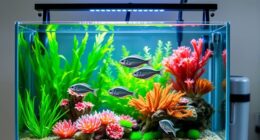Eco-friendly fabrics like organic cotton and bamboo offer sustainable options for your wardrobe. Organic cotton is grown without harmful chemicals, uses less water, and promotes soil health, while bamboo is fast-growing, naturally antimicrobial, and requires minimal pesticides. Both textiles are soft, breathable, and stylish, making them great choices for eco-conscious fashion. If you want to learn how these fabrics are made, their environmental impact, and future trends, keep exploring further.
Key Takeaways
- Organic cotton and bamboo are sustainable fabrics grown without harmful chemicals, promoting soil health, water conservation, and biodiversity.
- Bamboo fabric is naturally antimicrobial, highly breathable, and grows quickly without pesticides, making it eco-friendly and suitable for activewear.
- Both fabrics undergo eco-conscious processing methods, such as mechanical fiber extraction and closed-loop water systems, reducing pollution.
- Organic cotton reduces chemical runoff and uses less water and energy compared to conventional cotton, benefiting ecosystems and farmers’ health.
- Choosing eco-friendly fabrics supports sustainable fashion by minimizing environmental impact while offering comfortable, stylish clothing options.
What Is Organic Cotton and How Is It Made?

Have you ever wondered what makes organic cotton different from conventional cotton? Organic cotton is grown without synthetic chemicals, pesticides, or fertilizers. Instead, farmers use natural methods like crop rotation and composting to keep the soil healthy. This process reduces environmental harm and promotes biodiversity. The cotton plants are cultivated with sustainable practices, ensuring they aren’t exposed to harmful substances. During harvesting, the cotton is carefully picked by hand or machines that minimize damage. Unlike conventional cotton, organic cotton is processed without toxic chemicals, making it safer for farmers, workers, and consumers. The fibers are naturally soft and durable, making them ideal for eco-friendly clothing. Additionally, the entire production process emphasizes sustainable agriculture and reduces the carbon footprint associated with textile manufacturing. Overall, organic cotton emphasizes sustainability and health, making it a responsible choice for conscious consumers.
The Environmental Benefits of Organic Cotton
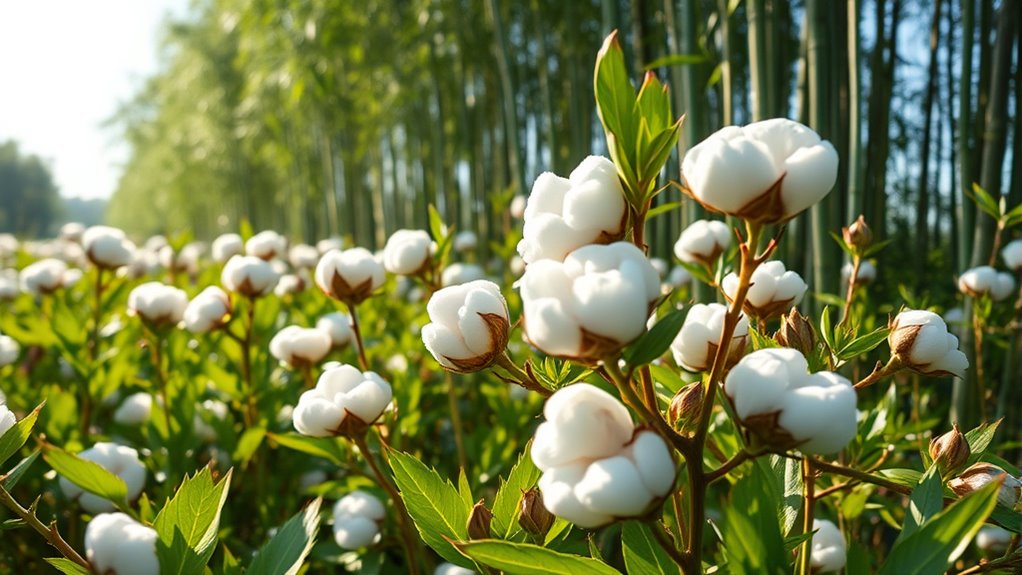
Organic cotton offers significant environmental advantages over conventional cotton, making it a more sustainable choice for eco-conscious consumers. It’s grown without synthetic pesticides or fertilizers, reducing chemical runoff that pollutes soil and water. By avoiding these chemicals, organic cotton preserves soil health and supports biodiversity, benefiting insects, birds, and other wildlife. Additionally, organic farming typically uses less water due to better soil management, conserving this essential resource. The absence of toxic chemicals also means safer working conditions for farmers and communities. Plus, organic cotton is biodegradable, reducing waste and pollution at the end of its life cycle. Choosing organic cotton helps lower your environmental footprint while promoting sustainable farming practices that protect ecosystems and future resources. Implementing chemical-free cultivation and crop rotation practices can further enhance environmental benefits and promote resilience in agricultural systems, especially when combined with Soil health management. Moreover, adopting water-efficient irrigation methods can further reduce water consumption and support water conservation efforts.
Bamboo Fabric: Characteristics and Uses
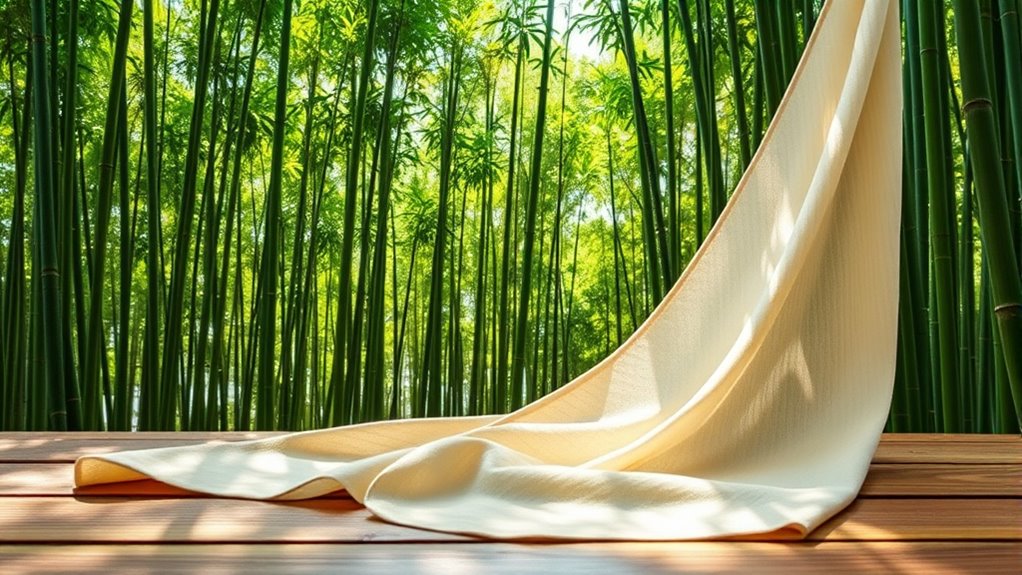
Bamboo fabric has gained popularity as a sustainable and versatile material in eco-friendly fashion. Its soft texture and breathability make it comfortable for everyday wear. Bamboo’s natural antimicrobial properties help keep odors at bay, reducing the need for frequent washing. This fabric is highly absorbent, making it ideal for activewear and loungewear. Additionally, bamboo grows quickly without pesticides or fertilizers, making it an eco-conscious choice. Its use in clothing aligns with the principles of sustainable materials, which aim to reduce environmental impact. Because bamboo cultivation can help soil conservation, it further supports ecological balance and promotes environmental sustainability. Moreover, the cultivation of bamboo can also contribute to carbon sequestration, helping to mitigate climate change. Implementing such practices in bamboo farming demonstrates a commitment to ethical harvesting and responsible resource management.
Comparing Sustainability: Organic Cotton vs. Conventional Cotton

When comparing organic cotton to conventional cotton, you’ll notice significant differences in environmental impact and resource use. Organic farming generally reduces water and chemical use, making it more sustainable overall. Understanding these distinctions helps you make eco-conscious choices for your wardrobe. Additionally, choosing organic cotton supports sustainable farming practices, which benefit ecosystems and promote healthier soil. Using organic cotton also helps reduce the chemical footprint associated with textile production, contributing to a healthier environment. Furthermore, organic cotton farming often relies on natural pest control, which minimizes the need for synthetic pesticides and herbicides. Incorporating sustainable practices can further enhance the positive impact of your choices on the environment.
Environmental Impact Differences
While both organic and conventional cotton are popular choices for clothing, their environmental impacts differ remarkably. Organic cotton is grown without synthetic pesticides or fertilizers, reducing chemical runoff and soil contamination. Conventional cotton relies heavily on these chemicals, which can harm ecosystems and pollute water sources. Additionally, organic farming typically uses less energy because it avoids synthetic inputs. Here are key differences:
- Chemical Use: Organic cotton avoids harmful chemicals, protecting wildlife and farmers’ health.
- Soil Health: Organic farming enhances soil fertility through natural methods, unlike conventional practices that deplete nutrients. Implementing sustainable farming practices can further improve environmental outcomes.
- Water Pollution: Conventional cotton’s chemical runoff contaminates water supplies, while organic cotton minimizes this risk.
- Data analytics also play a role in improving farming practices by tracking resource usage and crop health, further supporting sustainable agriculture.
These factors make organic cotton a more environmentally friendly option overall.
Resource Consumption Levels
Have you ever wondered how much water and energy go into producing different types of cotton? Conventional cotton requires large amounts of water for irrigation and substantial energy for processing, making it resource-intensive. It often relies on synthetic fertilizers and pesticides, which increase energy use and environmental strain. In contrast, organic cotton minimizes chemical inputs, reducing energy consumption and water pollution. Organic farming methods promote soil health, leading to less water needed for irrigation over time. While organic cotton might still use significant resources, it generally consumes less water and energy compared to conventional cotton. If you’re aiming for sustainability, choosing organic cotton helps reduce resource depletion and lowers your environmental footprint. Understanding these differences helps you make more eco-conscious decisions in your fabric choices.
The Manufacturing Process of Bamboo Fabric
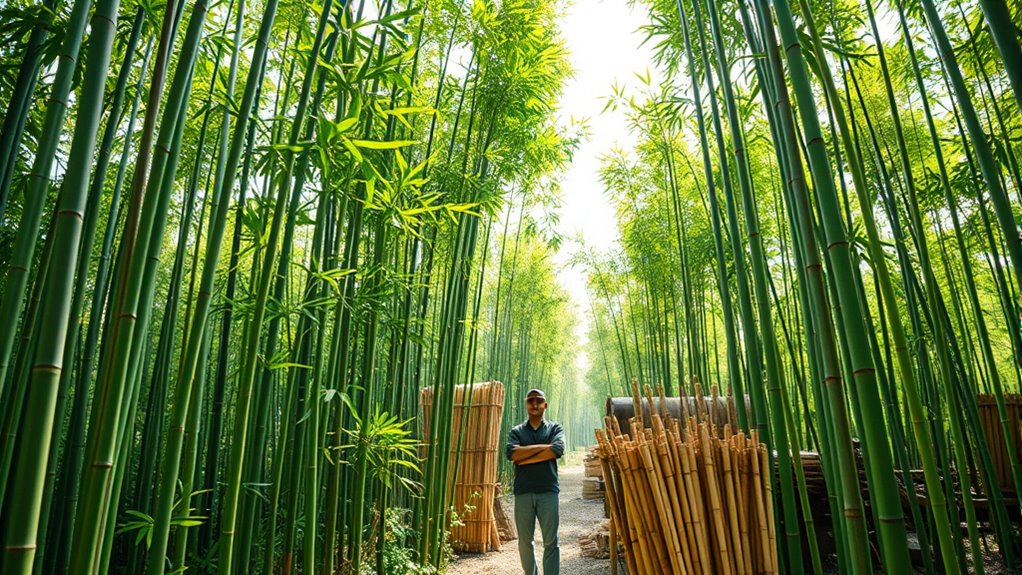
You might be surprised by how bamboo is cultivated using eco-friendly techniques that reduce water and pesticide use. When extracting fibers, manufacturers often choose sustainable methods that minimize chemical use and waste. By focusing on sustainable processing practices, the entire production of bamboo fabric becomes more environmentally responsible. Additionally, some manufacturers incorporate Ford Tuning principles to optimize the production process, ensuring maximum efficiency with minimal environmental impact. Implementing fire safety measures during production further enhances the sustainability and safety of bamboo fabric manufacturing.
Bamboo Cultivation Techniques
Bamboo cultivation for fabric production involves a carefully managed process that guarantees sustainable and efficient fiber extraction. You focus on selecting fast-growing bamboo species that thrive without pesticides or chemical fertilizers. Proper spacing ensures healthy growth and prevents overcrowding, which can lead to disease. Regular watering and natural mulching promote robust plants, while avoiding synthetic chemicals keeps the process eco-friendly. To optimize yield, you implement crop rotation and soil enrichment techniques. Additionally, maintaining a healthy soil environment is essential for sustainable growth and fiber quality. Incorporating integrated pest management strategies further supports eco-friendly cultivation by minimizing the need for chemical interventions. Moreover, adopting water conservation practices helps reduce environmental impact and ensures the sustainability of bamboo farming.
Fiber Extraction Methods
The fiber extraction process transforms harvested bamboo into usable fabric through a series of environmentally conscious methods. First, you harvest mature bamboo stalks, then crush or cut them into smaller pieces. Unlike traditional methods, eco-friendly extraction uses mechanical processes like crushing and retting, avoiding harmful chemicals. During retting, bamboo fibers are separated from the woody parts naturally, often using water or enzymes. This gentle process preserves fiber integrity while minimizing pollution. Once the fibers are freed, they’re cleaned and combed to remove residual plant material. The result is a clean, raw bamboo fiber ready for spinning. This method reduces water and chemical use, making the entire extraction process more sustainable. Additionally, regulatory compliance ensures that the process meets environmental standards, further supporting eco-friendly manufacturing. The use of environmentally friendly techniques helps reduce the carbon footprint associated with traditional fiber extraction methods. Incorporating sustainable practices throughout the process enhances the overall ecological benefits. Implementing certification standards helps verify the eco-friendliness of the process and builds consumer trust. Moreover, utilizing innovative extraction methods can further improve efficiency and fiber quality. You get high-quality bamboo fibers that serve as the foundation for eco-friendly fabrics.
Sustainable Processing Practices
Sustainable processing practices focus on minimizing environmental impact throughout the manufacturing of bamboo fabric. To achieve this, you should consider methods that reduce chemical use, conserve water, and lower energy consumption. First, opting for mechanical processing techniques transforms bamboo into fabric without harsh chemicals, making it eco-friendlier. Second, implementing closed-loop water systems ensures water reuse, decreasing waste and pollution. Third, using renewable energy sources like solar or wind power in production reduces carbon emissions. These practices not only protect ecosystems but also enhance the sustainability of bamboo fabric. By prioritizing these steps, you help create an environmentally responsible product that aligns with eco-conscious values and supports a healthier planet.
Comfort and Style in Eco-Friendly Textiles
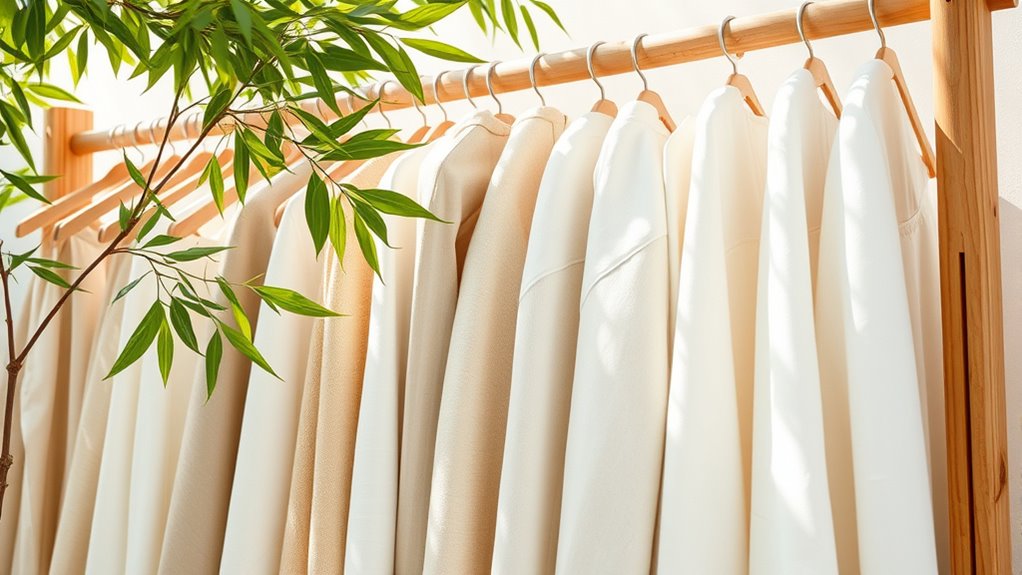
While eco-friendly textiles have traditionally focused on environmental benefits, they also deliver impressive comfort and style. Modern fabrics like organic cotton and bamboo feel soft against your skin and breathe well, making them perfect for daily wear. They come in a variety of textures, colors, and cuts that suit any fashion sense. You can enjoy eco-conscious clothing without sacrificing trendiness or comfort. To help you compare, here’s a quick look:
| Fabric | Comfort Level | Style Options |
|---|---|---|
| Organic Cotton | Soft, breathable | Classic, casual |
| Bamboo | Silky, cooling | Modern, sleek |
| Hemp | Durable, textured | Edgy, rustic |
| Tencel | Smooth, lightweight | Elegant, versatile |
Challenges and Limitations of Sustainable Fabrics
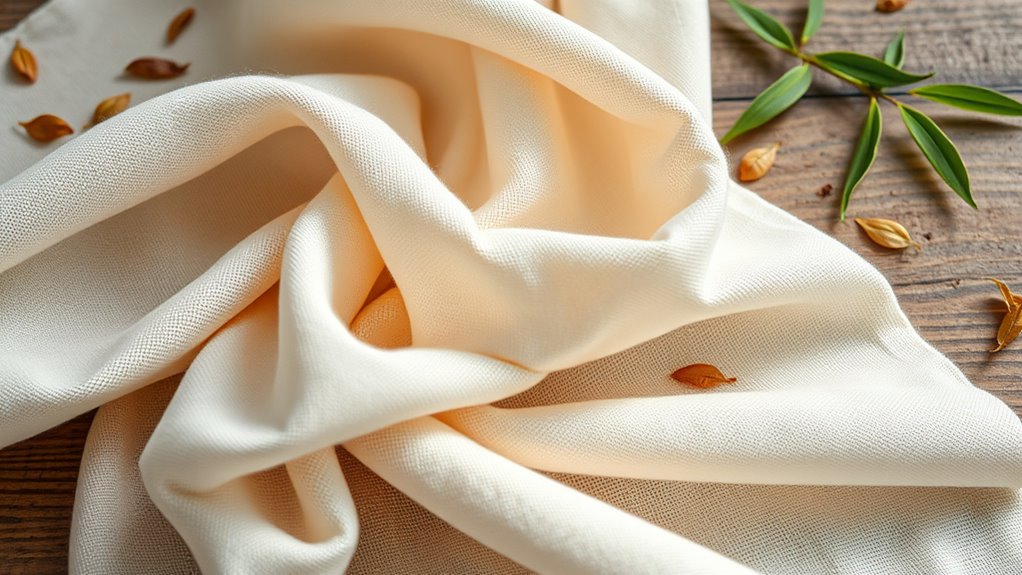
You might find that sustainable fabrics often require more agricultural land, which can strain resources. Water consumption and the need for energy and chemicals can also offset their environmental benefits. Understanding these challenges helps you make more informed choices about eco-friendly textiles.
Agricultural Land Use
Cultivating crops for eco-friendly fabrics often demands significant agricultural land, which can strain existing resources and lead to environmental challenges. You might find that expanding farmland for organic cotton or bamboo reduces space for food crops, risking food security. Additionally, large-scale cultivation can cause habitat loss and disrupt local ecosystems. To minimize these issues, consider:
- Efficient land management practices that optimize crop yields without expanding farmland.
- Prioritizing crop rotation to maintain soil health and reduce land degradation.
- Supporting alternative fibers that require less land or are cultivated on degraded land to avoid further environmental impact.
Balancing the need for sustainable fabrics with land conservation remains a key challenge, urging you to seek innovative solutions that lessen land use pressures.
Water Consumption Concerns
Have you ever contemplated how much water sustainable fabrics require during their production? While organic cotton and bamboo are often praised for being eco-friendly, they still demand significant water resources. Growing organic cotton, for example, can use up to 2,260 liters of water per kilogram, which is less than conventional cotton but still substantial. Bamboo cultivation varies; some methods need ample water, especially in non-native environments. Water scarcity in many regions poses a challenge, making it hard to produce these fabrics sustainably everywhere. Additionally, many sustainable fabrics require water-intensive processing methods, such as washing and dyeing, which can negate some environmental benefits. As you pursue eco-friendly options, it’s essential to consider water use to truly minimize your environmental impact.
Energy and Chemical Inputs
While sustainable fabrics are often promoted as eco-friendly alternatives, they still require significant energy and chemical inputs during production. These inputs can offset some of their environmental benefits if not managed carefully. For example, producing bamboo fabric involves intensive processing with chemicals to convert raw bamboo into fiber, which can cause pollution. Organic cotton, though grown without pesticides, still consumes considerable energy for irrigation and machinery. Additionally, the chemical treatments used to improve fabric durability or appearance can introduce toxicity if not properly controlled.
You should consider:
- The energy-intensive processes involved in transforming raw materials into usable fabrics.
- The reliance on chemicals that may pose environmental and health risks.
- The need for cleaner, more sustainable methods to reduce overall environmental impact.
Innovations in Eco-Friendly Fabric Technology

Innovations in eco-friendly fabric technology are transforming the fashion industry by making sustainable choices more accessible and effective. You now have options like recycled fibers, which turn plastic bottles into soft, durable textiles, reducing waste. Bio-based dyes are also advancing, cutting down water and chemical use while offering vibrant colors. Researchers are developing lab-grown fabrics like lab-grown leather and mycelium-based materials, which minimize environmental impact and animal harm. Nanotechnology is improving fabric durability and stain resistance without harmful chemicals. Additionally, innovations in waterless dyeing and low-impact finishing processes help conserve resources. These advancements enable you to choose textiles that are not only environmentally friendly but also high-performance, ensuring your style aligns with sustainability goals without sacrificing quality or aesthetics.
How to Identify Authentic Sustainable Textiles
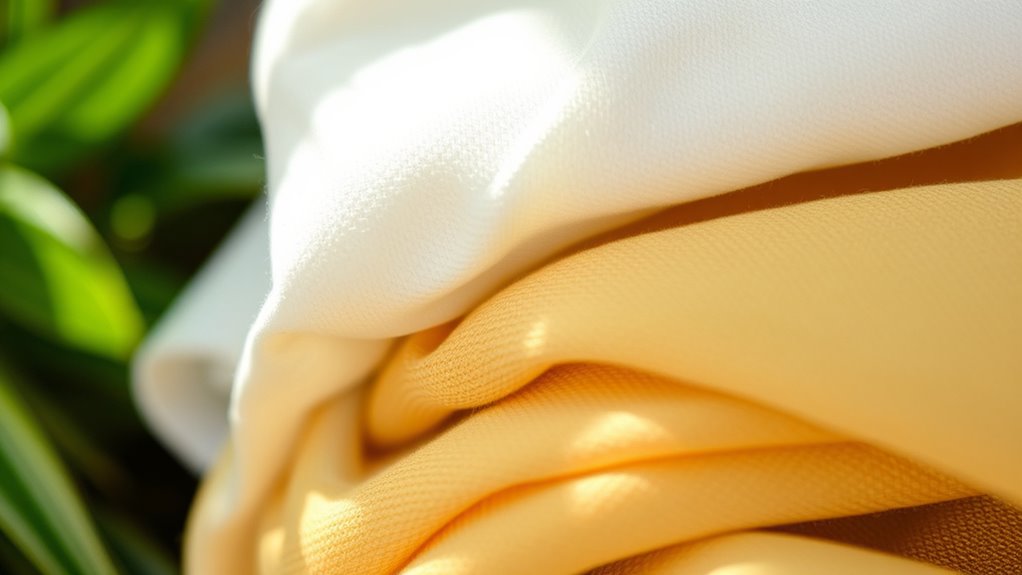
Wondering how to spot authentic sustainable textiles? It’s easier than you think if you know what to look for. First, check for certifications like GOTS, OEKO-TEX, or Fair Trade. These labels ensure the fabric meets strict environmental and social standards. Second, examine the fabric’s texture and quality; genuine eco-fabrics tend to feel softer, more breathable, and often have a natural finish without chemical coatings. Third, research the brand’s transparency—trustworthy companies openly share their sourcing and manufacturing processes. By paying attention to certifications, tactile qualities, and brand integrity, you can confidently identify authentic sustainable textiles and make eco-conscious choices in your wardrobe.
Future Trends in Eco-Conscious Fashion

Have you noticed how eco-conscious fashion is rapidly evolving? It’s shifting toward innovative materials like lab-grown fabrics, which reduce environmental impact and waste. Expect more brands to adopt circular design principles, creating pieces that are fully recyclable or biodegradable. Technology will play a bigger role, with smart textiles that monitor health or adapt to weather changes, all made sustainably. Transparency will become even more important, as consumers demand full supply chain clarity. You’ll see a rise in local, small-scale production to lower carbon footprints and support communities. Additionally, regenerative practices, such as soil restoration, will influence fiber sourcing. Overall, future trends will focus on blending sustainability with style, making eco-conscious choices easier and more appealing for you.
Frequently Asked Questions
Are Eco-Friendly Fabrics Suitable for All Skin Types?
You might wonder if eco-friendly fabrics suit all skin types. Generally, they’re a great choice because they’re often made from natural, breathable materials like organic cotton and bamboo. These fabrics tend to be gentle, reducing irritation and allergies. However, everyone’s skin is different, so it’s smart to test new fabrics first. If you have sensitive skin, look for labels that specify hypoallergenic or dermatologist-tested options for extra reassurance.
How Do Eco-Fabrics Compare in Durability to Traditional Textiles?
Imagine a sturdy oak standing firm through seasons—that’s how eco-fabrics compare to traditional textiles. You’ll find many eco-friendly options, like organic cotton and bamboo, are surprisingly durable, resisting wear over time. While some may worry about longevity, these fabrics often outlast synthetic counterparts, symbolizing resilience and harmony with nature. So, with proper care, eco-fabrics can be just as dependable, if not more so, as traditional textiles.
Can Sustainable Fabrics Be Recycled or Repurposed Easily?
You might wonder if sustainable fabrics can be recycled or repurposed easily. Generally, many eco-friendly textiles, like organic cotton or bamboo, are recyclable, but it depends on their blends and finishes. You’re more likely to recycle pure fibers than mixed materials. To repurpose, you can often upcycle these fabrics into new items, but it’s essential to check fabric labels and local recycling options to guarantee proper processing.
What Certifications Ensure the Authenticity of Eco-Friendly Fabrics?
Think of certifications as your eco-friendly fabric’s passport, proving its genuine sustainability. You should look for labels like GOTS (Global Organic Textile Standard), OEKO-TEX Standard 100, and FSC (Forest Stewardship Council). These certifications verify organic farming practices, chemical safety, and responsible forestry, ensuring your fabric isn’t just green in name but truly eco-friendly. Always check for reputable certification logos to confidently choose authentic sustainable textiles.
Are Eco-Fabrics More Cost-Effective Than Conventional Materials?
You might wonder if eco-fabrics cost more than traditional materials. Generally, eco-friendly fabrics can be pricier upfront due to sustainable farming and production methods. However, they often save you money long-term because they’re durable and require less maintenance. Plus, choosing eco-fabrics supports environmental health and reduces your carbon footprint. So, while initial costs can be higher, their overall value and benefits make them a smart investment.
Conclusion
Choosing eco-friendly fabrics means balancing beauty with responsibility. While organic cotton offers softness without pesticides, bamboo provides rapid renewal and durability. Yet, both face challenges—organic cotton’s water use, bamboo’s chemical processing. By understanding these contrasts, you empower your wardrobe with sustainability. Embrace innovations and make informed choices, knowing that what you wear can be both stylish and kind to the planet. Ultimately, your fashion choices shape a greener future—where nature’s resources thrive alongside your personal style.








